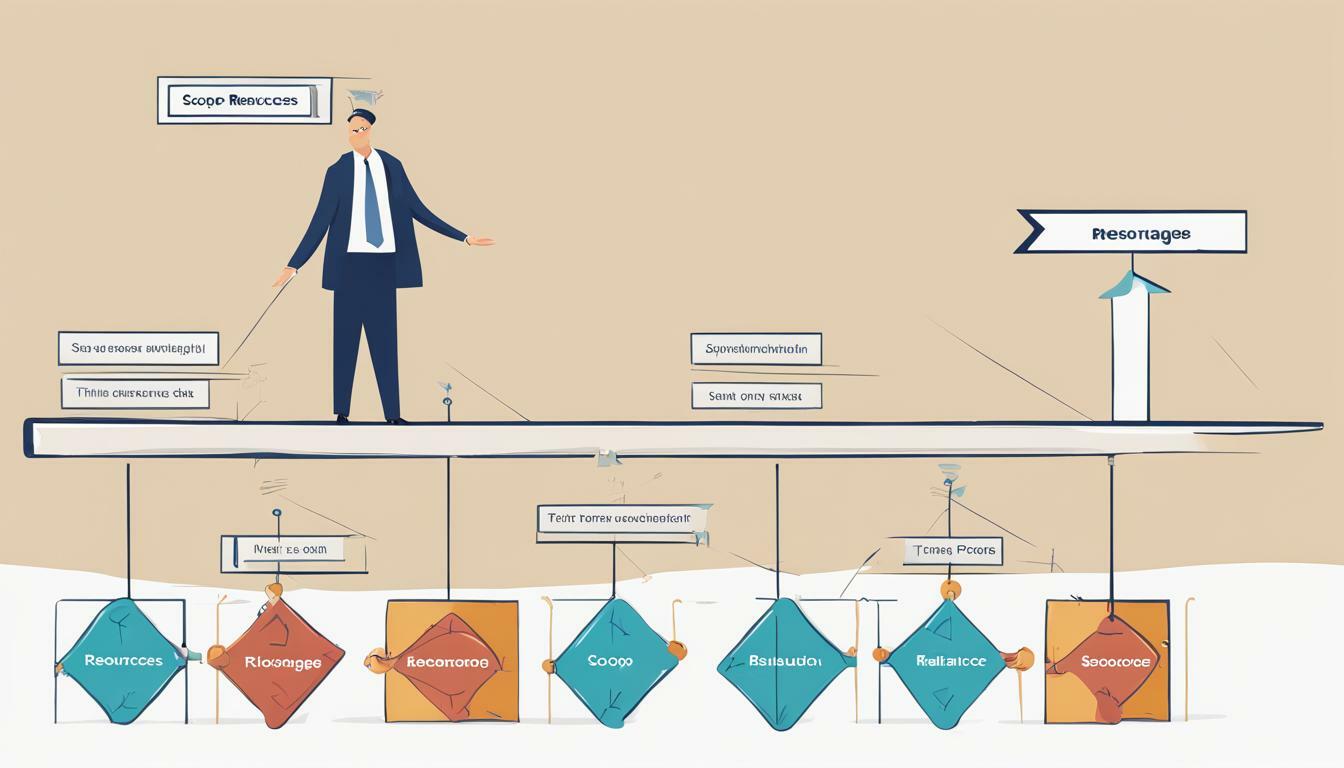
Project management is a complex undertaking that involves balancing multiple variables to achieve successful outcomes. The three key elements of project management- scope, time, and resources– are critical for project success. To effectively manage projects, it is important to understand the project management triangle and how it relates to project outcomes.
The project management triangle, also known as the triple constraint, is a framework used to balance scope, time, and resources. The concept is simple- any change in one of the three elements will impact the other two. It is the project manager’s responsibility to find an equilibrium that ensures project success.
Key Takeaways
- The project management triangle is a framework used to balance scope, time, and resources.
- Changes in one element of the triangle impact the other two, requiring project managers to find balance to achieve success.
Understanding the Project Management Triangle
Project management involves balancing three essential elements: scope, time, and resources. These three elements form what is commonly known as the Project Management Triangle. A successful project manager must balance these elements effectively to achieve project success.
Scope Management involves defining the goals and deliverables of a project. Clear definition of scope helps in avoiding scope creep, thus reducing project risks. Time Management involves efficient scheduling of project activities to ensure that the project is completed on time. Resource Management is all about optimizing project resources, including the budget and human capital.
It is essential to understand the relationship between these three elements. Any change in one element has an impact on the other two. For instance, changes to the project scope may impact the budget and timeline. In the same way, changes to the project schedule may impact the budget and scope. Therefore, maintaining balance is critical for project success.
Scope Management
Clear definition of scope is the first step towards project success. Understanding the project goals and deliverables helps in identifying the resources required. The scope document should include a detailed description of the project objectives, timelines, and assumptions. It should also define the project deliverables and acceptance criteria. Stakeholder engagement and requirements gathering help in achieving a clear scope definition.
Time Management
Time management is the most critical aspect of project management. A realistic timeline ensures that the project is completed on time. The timeline should include all critical activities, milestones, dependencies, and slack time. It should be reviewed regularly to ensure that the project is progressing as planned. Identifying critical paths and controlling project risks is essential for effective time management.
Resource Management
Optimizing project resources is essential for project success. It involves managing all project resources efficiently, including human capital, budget allocation, and equipment utilization. Effective resource management requires a clear understanding of the roles and responsibilities of all team members. It also involves identifying resource constraints and managing them proactively.
Understanding the project management triangle and its three key components is essential for successful project management. Balancing scope, time, and resources is critical for achieving project success. In the next section, we will discuss effective strategies for scope definition in more detail.
Scope Management: Defining Project Goals and Deliverables
Effective scope management is crucial for project success. It involves clearly defining project goals and deliverables to ensure that all stakeholders understand the project’s objectives. By doing so, it is possible to achieve a common understanding of what needs to be done, reducing the risk of misunderstandings and conflicts later on.
Project planning is a critical part of scope management. It involves defining project requirements and constraints, identifying stakeholders, and developing a project charter. A project charter outlines the project’s objectives, scope, resources, schedule, risks, and assumptions, providing a roadmap for the project’s execution.
Engaging stakeholders early in the project planning process is essential to ensuring that the project’s goals align with their expectations. Requirements gathering is a key component of stakeholder engagement, requiring clear communication and active listening to gather all necessary information.
In summary, effective scope management involves clear communication, stakeholder engagement, and requirements gathering. By defining project goals and deliverables, project managers can create a shared understanding of what needs to be done. This ensures that the project is executed successfully, meeting stakeholders’ expectations and delivering successful outcomes.
Time Management: Efficiently Scheduling Project Activities
As we discussed earlier, time management is a critical component of the project management triangle. Effective project scheduling can help ensure timely project delivery, mitigate risks, and minimize costs. Here are some key strategies for efficient time management during project planning and execution:
- Create realistic timelines: Set achievable deadlines and milestones based on the project scope and available resources. Consider factors such as task dependencies, resource availability, and potential risks that may impact project timelines.
- Identify critical milestones: Define key project milestones and track progress against them. This can help you stay on track and identify potential delays early on.
- Manage dependencies: Identify task dependencies and sequence them appropriately. This can help prevent project delays and ensure that tasks are completed in a logical order.
- Use project management tools: Time management tools, such as Gantt charts and project scheduling software, can help you manage your project timeline effectively. These tools can help you track progress, identify critical path tasks, and manage resource allocation.
- Regularly monitor and update project schedule: Regularly review project timelines, assess progress, and make necessary updates to keep the project on track. This can help you identify potential delays and take corrective action before they impact project delivery.
By using these strategies and tools, you can better manage your project timeline, minimize risks, and ensure timely project delivery. Effective time management is critical for successful project outcomes, and should be a key component of your project planning and execution process.
Resource Management: Optimizing Project Resources
Proper resource management is crucial for project success. In project planning, the project manager must identify the resources required to achieve project goals. Once identified, the resources must be efficiently allocated and utilized during project execution.
Here are some strategies for effective resource management:
- Human capital: Ensure that the right personnel with the required skills are assigned to project tasks. Consider outsourcing or hiring additional staff if necessary.
- Budget allocation: Allocate the budget in a way that maximizes the overall efficacy of the project. Prioritize spending on critical tasks and keep track of expenses to avoid overspending.
- Equipment utilization: Use equipment efficiently to avoid unnecessary downtime or overcapacity. Consider renting or leasing equipment if required for specific tasks.
The project manager must also remain adaptable in response to changing resource needs during project execution. Regular monitoring of resource utilization and implementation of corrective actions can help ensure optimal resource management.
Project Execution: Implementing Plans and Monitoring Progress
Once project planning is complete, the next step is project execution. Project execution refers to the implementation of plans and procedures necessary for completing project goals. Effective project execution requires diligent monitoring and control to ensure that project activities are on track and within scope, budget, and timeline.
Project control is an essential aspect of project execution. It involves monitoring and measuring project progress against set baselines, identifying and managing any deviations or variances, and taking corrective actions where necessary. A robust project control system is critical to ensuring that project outcomes meet the defined targets.
Techniques for Effective Project Control
Here are some techniques for effective project control:
- Regular progress tracking: Regular progress tracking is crucial for identifying issues early on and taking corrective actions. Project managers should use appropriate tools and techniques to track progress, such as Gantt charts, critical path analyses, and earned value management
- Risk management: Project managers should monitor project risks and take appropriate actions to mitigate or eliminate them. They should have a risk mitigation plan in place and be proactive in identifying and managing potential risks.
- Change control: Change is inevitable in any project. Project managers should have a change control process in place to manage changes effectively, ensuring that the project remains on track and within scope.
Effective project control requires strong leadership, effective communication, and the use of appropriate monitoring and control tools. By implementing these techniques, project managers can ensure that their projects proceed smoothly and achieve the defined project goals.
Achieving Project Success: Balancing the Triangle
Successfully balancing the project management triangle is essential for achieving project success. Balancing scope, time, and resources requires careful planning, execution, and monitoring. Project managers must be proactive in identifying potential issues and making necessary adjustments to maintain equilibrium among the three components.
The project management triangle is dynamic and subject to change, as project requirements and external factors evolve. As such, it is important for project managers to continually evaluate and adjust if necessary. The following tips and strategies can help maintain balance and achieve project success:
- Regularly communicate with stakeholders to understand shifting priorities and needs.
- Regularly evaluate project progress and identify potential risks and issues that may impact scope, time, or resources.
- Be flexible and open to changes in scope, time, and resources as needed.
- Employ effective change control processes to manage changes in scope, time, or resources.
- Ensure all team members are clear on project goals and expectations.
- Empower team members to take ownership of their work and contribute to project success.
By adopting these strategies and effectively balancing scope, time, and resources, project managers can achieve project success and deliver impactful results.
Conclusion
Mastering the project management triangle is essential for achieving successful project outcomes. By balancing scope, time, and resources, project managers can deliver impactful results and ensure project success. It is important to continuously improve and adapt to changing project dynamics to maintain balance among these critical project elements.
Effective scope management involves clearly defining project goals and deliverables, engaging stakeholders, and gathering requirements. Time management requires efficient project scheduling, realistic timelines, and critical milestone identification. Resource management maximizes project resources such as human capital, budget allocation, and equipment utilization. Project execution involves implementing plans, monitoring progress, and maintaining equilibrium among project elements.
To master the project management triangle, project managers should focus on understanding the project management triangle and its components. They must also learn to balance scope, time, and resources effectively to achieve project success. Continuous monitoring and adaptation to changing project dynamics are key to realizing success.
Mastering the Project Management Triangle
By mastering the project management triangle, project managers can unlock the potential for successful project outcomes. Effective management of scope, time, and resources can help in achieving project goals and deliverables on time and within budget constraints. However, it is important to note that there is no one-size-fits-all approach to mastering the project management triangle as the specific nature of each project may differ.
It is critical to continuously improve and adapt to changing project dynamics, ensure stakeholder engagement, and manage risks effectively. By focusing on these key areas, project managers can achieve success in mastering the project management triangle.
FAQ
Q: What is the project management triangle?
A: The project management triangle, also known as the triple constraint, is a framework that represents the interdependency between three key elements of a project: scope, time, and resources. It illustrates that changes in one element will impact the other two, requiring project managers to carefully balance and manage these components.
Q: Why is balancing scope, time, and resources important?
A: Balancing scope, time, and resources is crucial for project success because it ensures that project goals are achieved within the allocated time and resources. Failing to manage any of these elements effectively can lead to scope creep, missed deadlines, and resource constraints, resulting in project failure.
Q: What strategies can be used for effective scope management?
A: Effective scope management involves clearly defining project goals and deliverables. Strategies such as stakeholder engagement, requirements gathering, and regular scope reviews can help ensure that the project stays on track and meets the desired outcomes.
Q: How can time management be improved in project planning?
A: Improving time management in project planning requires creating realistic timelines, identifying critical milestones, and managing dependencies. Techniques like Agile methodologies, Gantt charts, and efficient task allocation can help optimize project schedules and ensure timely completion.
Q: What are the key aspects of resource management in project execution?
A: Resource management in project execution involves optimizing various resources such as human capital, budget allocation, and equipment utilization. Effective resource allocation, regular monitoring, and contingency planning are essential to ensure that project resources are utilized efficiently.
Q: What techniques can be used for successful project execution?
A: Successful project execution involves implementing plans and monitoring progress. Techniques such as regular progress tracking, risk management, and change control can help project managers stay in control of the project, identify and address issues promptly, and ensure smooth project delivery.
Q: What is the significance of balancing the project management triangle?
A: Balancing the project management triangle is crucial for achieving project success. By maintaining equilibrium among scope, time, and resources, project managers can ensure that project goals are met, deadlines are adhered to, and resources are utilized optimally.








